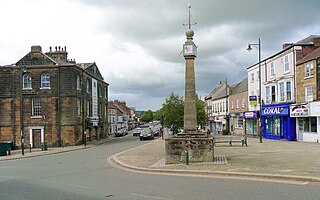
Guisborough is a market town and civil parish in the borough of Redcar and Cleveland, North Yorkshire, England. It lies north of the North York Moors National Park. Roseberry Topping, midway between the town and Great Ayton, is a landmark in the national park. It was governed by an urban district and rural district in the North Riding of Yorkshire.

The North Riding of Yorkshire was a subdivision of Yorkshire, England, alongside York, the East Riding and West Riding. The riding's highest point was at Mickle Fell at 2,585 ft (788 m).
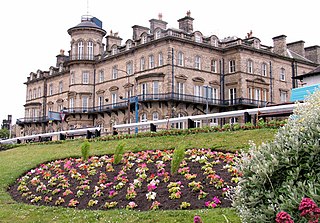
Saltburn-by-the-Sea, commonly referred to as Saltburn, is a seaside town in the civil parish of Saltburn, Marske and New Marske, in the Redcar and Cleveland district, in North Yorkshire, England, 12 miles (19 km) south-east of Hartlepool and 5 miles (8 km) south-east of Redcar. It lies within the historic boundaries of the North Riding of Yorkshire.
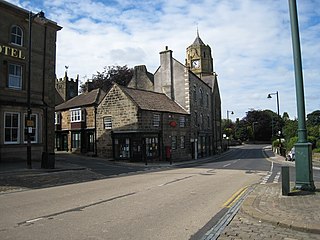
Loftus is a market town and civil parish in the Redcar and Cleveland borough of North Yorkshire, England. The town is located north of the North York Moors and sits between Whitby and Skelton-in-Cleveland. The parish includes the villages of Carlin How, Easington, Liverton, Liverton Mines and Skinningrove. It is near Brotton, Saltburn and Skelton-in-Cleveland.
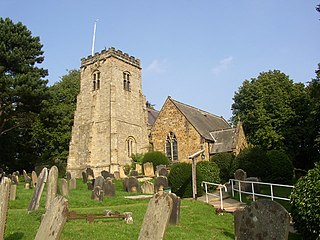
Scalby, a village on the north edge of Scarborough, North Yorkshire, England, is part of the civil parish of Newby and Scalby. From 1902 to 1974, Scalby was an urban district in the North Riding of Yorkshire.

Skinningrove is a village in the civil parish of Loftus, in the Redcar and Cleveland district, in the ceremonial county of North Yorkshire, England. Its name is of Old Norse etymology and is thought to mean skinners' grove or pit.

Kilton is a village in the civil parish of Lockwood, in the borough of Redcar and Cleveland, in the ceremonial county of North Yorkshire, England.

Kilton Thorpe is a village in the borough of Redcar and Cleveland and the ceremonial county of North Yorkshire, England. Noted for evidence of early settlement. The outlines of an ancient village are visible in fields adjacent to the present village.

North Skelton is a village in Redcar and Cleveland, North Yorkshire, England.
The Cleveland Railway was a railway line in north-east England running from Normanby Jetty on the River Tees, near Middlesbrough, via Normanby and then via Guisborough through the Eston Hills, to Loftus in East Cleveland. It carried minerals from numerous iron ore mines along its route to the River Tees for shipment to Tyneside and elsewhere. The line was jointly proposed by the West Hartlepool Harbour and Railway (WHH&R), who provided half its capital, together with various landowners. The WHH&R lay on the north bank of the Tees, to which it had a cross-river connection via a jetty at Normanby.

Hawsker is the name for the combined villages of High and Low Hawsker that straddle the A171 road 2.5 miles (4 km) southeast of Whitby, in North Yorkshire, England.

Kilton Castle is a ruined castle overlooking the valley of Kilton Beck, near to the village of Kilton in the historic county of the North Riding of Yorkshire in England. The castle was built in the 12th century and was described as being in a ruinous state by the 14th century, with it being totally abandoned by the 16th century. Kilton Castle was owned by several noble families who hailed from the area; de Brus, de Kilton, Autrey, de Thweng, de Lumley.

The Woodsmith Mine Tunnel is a 23-mile (37 km) long tunnel that will stretch between Woodsmith Mine at Sneatonthorpe near Whitby in North Yorkshire and the Wilton International complex on Teesside, England. The tunnel has been in development since 2016, but cutting of the tunnel bore did not start until April 2019, with a projected finish date of 2021; it was, however, still not complete by December 2023, when more than 16 miles (25.8 km) had been dug.

Scaling Dam Reservoir is a freshwater man-made lake on the edge of the A171 road in North Yorkshire, England. The reservoir is near to the hamlet of Scaling from where it derives its name, and was built in 1958.

Kettleness, is a hamlet in the Scarborough District of North Yorkshire, England. The settlement only consists of half-a-dozen houses, but up until the early 19th century, it was a much larger village. However, most of that village, which was on the headland, slipped into the sea as a result of instability caused by quarrying for the alum industry. Kettleness became a smaller settlement, with houses rebuilt slightly further inland.
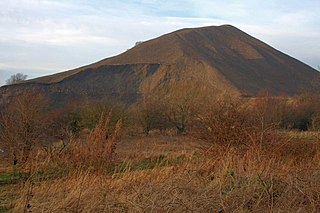
Ironstone mining in Cleveland and North Yorkshire occurred on a sizeable scale from the 1830s to the 1960s in present-day eastern parts of North Yorkshire but was recorded as far back as Roman times mostly on a small scale and intended for local use. This Cleveland is not to be confused with a smaller area covered by the county of Cleveland from 1974-96.

Kilton Viaduct was a railway viaduct that straddled Kilton Beck, near to Loftus, in North Yorkshire, England. The viaduct was opened to traffic in 1867, however in 1911, with the viaduct suffering subsidence from the nearby ironstone mining, the whole structure was encased in waste material from the mines creating an embankment which re-opened fully to traffic in 1913. The railway closed in 1963, but then in 1974, it re-opened as part of the freight line to Boulby Mine carrying potash traffic.
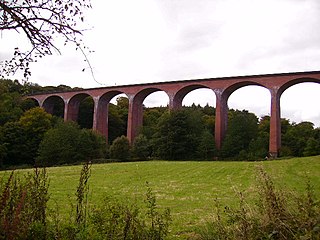
Saltburn Viaduct is a railway bridge in Redcar and Cleveland, North Yorkshire, England. The line was built as an extension of the Redcar and Saltburn Railway, and the viaduct is mostly built out of brick. The line opened to passengers in 1872, but became freight only in 1957, a purpose for which it still is in use for today as part of the Boulby line.
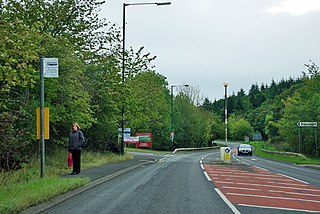
Slapewath is a hamlet in the borough of Redcar and Cleveland and the ceremonial county of North Yorkshire, England. Whilst the name of the hamlet is recorded as far back as the 13th century, it was developed due to the alum and ironstone industries of the North-Eastern part of Yorkshire in the 16th and 19th centuries respectively. The hamlet lies on the A171 road.

The Boulby line is a freight-only railway line in Redcar and Cleveland, England. The line was opened in stages between 1865 and 1882, being part of two railways that met at Brotton railway station. Passenger trains along the line ceased in 1960, and since then it has been a freight-only line dedicated to the potash and polyhalite traffic from Boulby, and steel products into Skinningrove Steelworks.


















